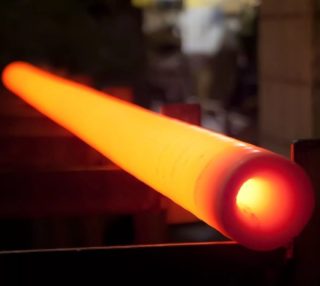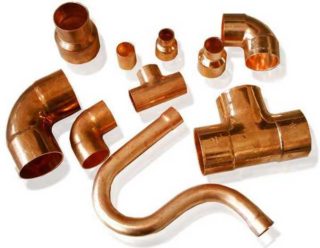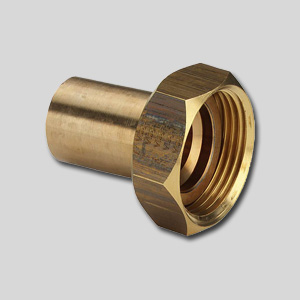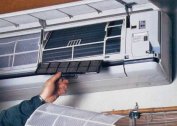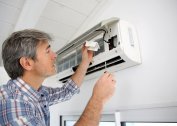The demand for domestic air conditioners and industrial air conditioning systems is increasing. This is due to the natural desire of people to create comfortable climatic conditions in the rooms where they spend most of the time. In turn, this significantly influenced the need for consumables used during installation and installation of this kind of equipment. One of these consumables, and the most common one, is a copper pipe, with the help of which pipelines are mounted connecting all the system units together.
Tubes for air conditioning
When carrying out work related to the installation of HVAC equipment, there is a need to create communications designed to transport refrigerant from one unit to another. Most often they use copper tubes for air conditioners.
The use of copper is due to a set of positive qualities that leave aluminum, steel or plastic far behind:
- chemical inertness with respect to refrigerants (freon, freon, etc.) used in air conditioning systems;
- high melting point (+ 1083 ° С) and thermal conductivity (400 W / m * K);
- minimum content in the chemical composition of potentially hazardous impurities for humans;
- high anti-corrosion properties of the outer and inner surfaces of the pipes, which are ensured by the appearance of a resistant oxide film;
- minimal roughness of internal surfaces;
- heat resistance, ductility, gas impermeability, etc.
Industrial enterprises produce tubes for air conditioners from copper of the M1p TU 184450-106-181-2006 brand, being guided by the provisions of GOST 617-2006.
M1p grade copper is obtained by remelting copper cathodes and copper scrap with phosphorus deoxidation. Moreover, in terms of chemical composition (not less than 99.9% Cu + Ag), the alloy corresponds to Cu-DLP grade copper (Euronorm EN 1652: 1998).
Varieties of Copper Tubes
For work as a part of conditioning systems copper tubes of 2 types are used:
- unannealed, with increased strength;
- annealed, characterized by greater ductility.
In order to give them high ductility, the tubes are additionally subjected to one of the types of heat treatment - annealing.
Annealing is a technological process in which parts are placed in a special furnace and heated to a temperature of + 700 ° C. Then they are cooled in the open air, as a result of which they become softer and more elastic. In this case, the strength characteristics of the material slightly deteriorate.
Comparative characteristics of the tubes are given in the table.
| Parameters | Annealed | Unburnt |
| Strength, kPa | 210000…220000 | 280000…300000 |
| Breaking elongation,% | 50…60 | 10…15 |
As a rule, copper tubes intended for transporting refrigerant are not included in the delivery package of the air conditioner and must be ordered separately. Wherein:
- unannealed - are delivered in the form of measuring segments (rods) having a length of not more than 5 m. In order to avoid dust particles and foreign objects getting into the tubes, their ends are closed with plugs.
- annealed, the length of which is 15 ... 50 m - delivered in bays, packed in plastic bags.
There are also tubes, additionally insulated with “covers” made of polyethylene or foamed non-porous rubber. They do this in order to exclude the possibility of temperature loss in highways mounted from thin-walled pipes.
When arranging air conditioning systems, annealed type copper pipes are more often used. This is due to the fact that they allow you to mount pipelines of the most complex shape. Such pipes easily bend at any angle, without changing their shape. When flaring at joints, it is easy to obtain airtight joints.
Assortment of copper tubes
Choosing the necessary materials for pipelines connecting the individual nodes of the air conditioners with each other, special attention is paid to the diameter of the copper tubes. Not only the rate of circulation of the refrigerant between the units depends on its value, but also the magnitude of the pressure loss in the end devices that cool the air.
The nomenclature of manufactured copper pipes is very diverse, but when forming pipelines for HVAC equipment, as a rule, certain standard sizes are used. Moreover, the thickness of their walls rarely exceeds 0.7 mm.
The diameter of the pipes is selected based on the power of the air conditioner - the higher the power, the larger the diameter. Most often, copper tubes are used for air conditioners, the diameters of which are given in the table.
| Diameter of copper tubes for air conditioners | |
| mm | inch |
| 6,35 | 1/4 |
| 9,52 | 3/8 |
| 12,7 | 1/2 |
| 15,88 | 5/8 |
| 19,05 | 3/4 |
When choosing the sizes of copper tubes for air conditioners, you need to remember that their blocks are connected together by two pipelines:
- gas, which serves to supply a gaseous substance from the compressor to the condenser and from the evaporator to the compressor;
- liquid, with which a liquid substance is supplied from the condenser to the evaporator.
In this case, the diameter of the tubes of the gas main should be larger than that of the liquid.
As for their length, it all depends on the distance between the air conditioning units. As a rule, when installing a single air conditioner, measured sections of tubes with a length of 2 to 5 m are used. If a large air conditioning system is installed, it is more advisable to purchase tubes in bays.
Installation of pipelines
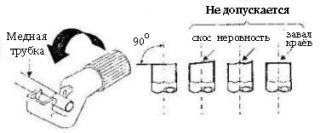 Having determined the location of the main units of the air conditioning system, proceed to the process of forming connecting pipelines. A series of preliminary operations precedes the process:
Having determined the location of the main units of the air conditioning system, proceed to the process of forming connecting pipelines. A series of preliminary operations precedes the process:
- development and marking of the optimal route for laying the route;
- determination of the length of pipelines;
- construction work (if necessary): wall breaking, punching holes in walls, etc .;
- preparation of materials and tools that may be needed when performing work.
In order to correctly assemble the pipeline, its estimated length needs to be increased by 0.8 ... 1.2 m. This will allow painlessly eliminating defects that may occur when connecting the pipes.
Mounting the pipeline, it is placed in a special box. Only after laying and fixing the pipeline do air conditioning units be installed. Then the pipes and blocks are connected into a single system and check its tightness.
To connect the tubes using union nuts and soldering. At the same time, at the junction points, the free ends of the tubes are cut off, and the cut points are carefully cleaned from burrs.
Cut the tubes only using a special pipe cutter. The use of a hacksaw or grinder is not allowed, as this can lead to small sawdust getting into the pipe and circulating them through the system. In turn, this can lead to blockage of the capillary tube of the air conditioner, the diameter of which does not exceed 0.8 mm.
During the work, it is allowed to use copper connecting fittings. However, it is allowed to install them only in those places where there are conditions for controlling the girth strength of the elements during operation of the air conditioner.
Solder connection
The use of soldering when connecting copper tubes is considered not only the most reliable, but also the cheapest way to ensure complete tightness of the connection. Soldering copper tubes is carried out in the following sequence:
- the end of one of the tubes is expanded using a special rolling nozzle;
- thoroughly clean and degrease the connected ends of the tubes from the oxide film and insert them into each other to a length approximately corresponding to their diameter;
- evenly apply liquid or paste flux to the junction;
- the surfaces to be connected are heated by the burner until the solder begins to melt from contact with the junction;
- fill the junction with solder, ensuring its penetration into the gap between the tubes inserted one into one;
- cool the junction in vivo and remove excess flux from the surface of the tubes.
When soldering copper pipelines, only copper-silver or copper-phosphorus solder is used.
Flare nut connections
Couplings with union nuts are most often used when connecting pipelines to air conditioning units with corresponding outlet pipes.
In order to connect the free end of the pipeline with a threaded pipe, the tube must first be expanded using a special rolling nozzle of a suitable diameter.
Before flaring the free end of the copper tube, do not forget to put on the union nut removed from the nozzle exiting the air conditioning unit.
After the end of the tube is correctly and accurately expanded, the pipeline is connected to the corresponding pipe of the air conditioning unit. To do this, combine the output flange with the socket of the pipe as even as possible and tighten the union nut by hand. The nut should tighten freely along the entire threaded length of the pipe. Only then can the connection be carefully tightened with a wrench. Excessive tightening force can cut off the flared flange, and insufficient - will not provide the necessary tightness of the pipeline.

